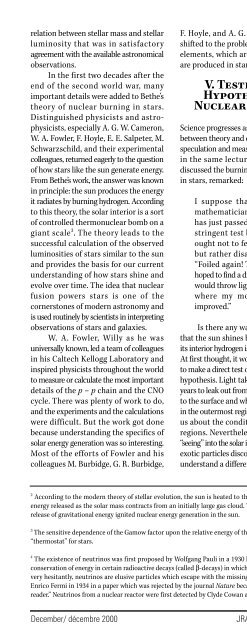I N S I D E T H I S I S S U E
insidethisissue - The Royal Astronomical Society of Canada
insidethisissue - The Royal Astronomical Society of Canada
- No tags were found...
You also want an ePaper? Increase the reach of your titles
YUMPU automatically turns print PDFs into web optimized ePapers that Google loves.
the resulting transformation coefficients are: 0.091, –0.019, –0.072and –0.107 for the B, V, R and I filters, respectively. Each of these valueshas an estimated uncertainty of 0.01, and part of this uncertainty isdue to the slight variability of Peg (Sinnott & Perryman 1997).3. ResultsIndividual photoelectric magnitude measurements of Mars are listedin Table II. As in previous studies, Mars was broken up into 12 longituderanges. Normalized magnitudes at a solar phase angle , for eachfilter were calculated. The normalized magnitude of Mars for theV–filter was calculated from:V (1,) = -5.000 log [rd] + 2.5 log [k], (1)where V is the measured V–filter magnitude, r is the Mars–Earthdistance, d is the Mars–Sun distance and k is the fraction of Mars’disc that is illuminated by the Sun as seen from the Earth; both r andd are in astronomical units. Normalized magnitudes for the B, R andI filters were calculated in a similar way. The normalized magnitudefor each filter was then plotted against the solar phase angle () asin previous studies; there was a total of 48 graphs (four filters for 12longitude ranges); a sample graph is shown in figure 1. The data forB–V, V–R, and B–R colour indices. One trend in the data is that Marswas redder in the 1995 and 1997 apparitions compared to the 1999apparition. This colour change may be seasonal and due to the 1999measurements being made during a cloudy season on Mars. Beish &Parker (1988) report that the frequency of discrete clouds reaches apeak in early northern summer (L s = ~ 110°). Increased clouds willmake Mars both brighter and less red. Based on the cloud trendssummarized by Beish & Parker (1988) the author expects Mars to beredder and have a dimmer V(1,0) value in 2001, since the number ofclouds are expected to be lower.Photoelectric magnitude measurements were made on February22, 1999 at central meridians of 67°, 80° and 96°W, which were neara dust storm (McKim, BAA Circ. #4). The B–R colour indices, whenthe solar phase angle is taken into account, are about 0.05 magnitudehigher than expected, indicating that the dust made Mars a littleredder.Table V lists the difference between maximum and minimumbrightness at =0° for different filters during the last four apparitions.The major trend here is that the difference between the brightest anddimmest longitudes increases with increasing wavelength. This isconsistent with the fact that blue light photographs show less contrastthan red light photographs (Slipher 1962). Figure 2 is a plot of theFig. 2 — A plot of the measured B–R colour indices for solar phase anglesof 0, 18 and 36 degrees as a function of longitude for 1999.Fig. 1 — A plot of the normalized magnitude versus the solar phase angle.each graph were fitted to a least squares routine and both the slopeand y–intercept were evaluated. The slope is the solar phase anglecoefficient [c B , c V , c R and c I for the B, V, R and I filters] and the y–interceptis the normalized magnitude at a solar phase angle of 0°; the symbolsfor the normalized magnitude for = 0° in the B, V, R and I filters are:B(1,0), V(1,0), R(1,0) and I(1,0). Average values of the solar phase anglecoefficient and normalized magnitude for each filter were determinedfrom an equally weighted average of the values of all 12 longituderanges; the results are listed in Table III.4. DiscussionThe normalized magnitudes at a solar phase angle of 0°for the lastfour Mars apparitions are summarized in Table IV along with the1999 B–R colour indices at = 0°, 18° and 36° as a function of thelongitude of the central meridian. The figure shows that Mars isreddest at longitudes from 100°–220°W; furthermore the B–R colourindices changed by up to 0.3 magnitude (or about 30%) for differentlongitudes. It is therefore concluded that Mars’ colour changed by upto 30% as a function of longitude in 1999.The V–filter magnitude between November 29, 1998 and May20, 1999 are, on average, 0.04 magnitude brighter than the valueslisted in The Astronomical Almanac (1997, 1998). The discrepancywas even greater for the longitudes between 70° W and 220° W wheredifferences of 0.06 to 0.11 magnitude were observed. These observationsare consistent with the surface of Mars; essentially there are fewerdark areas in the northern hemisphere between 70° W and 220° Wthan at other longitudes, and so Mars should be brighter when thecentral meridian is between 70° W and 220° W longitude.242JRASCDecember/ décembre 2000
















